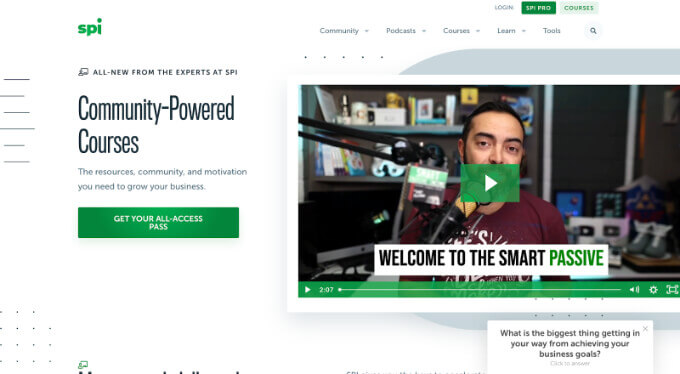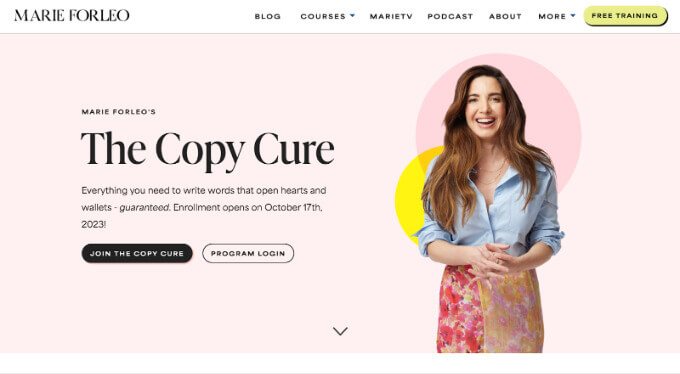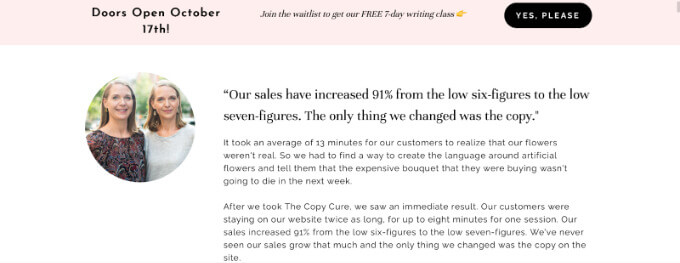Great course content is just part of the equation for success. What you need on top of it to provide a wholesome customer experience is good course branding.
Let’s discover how you can build a brand that resonates with every stage of the customer journey.
So, if you are ready, let’s start!
The following article covers:
The magic behind a strong online course brand
3 stages of building a defined online course brand
The magic behind a strong online course brand
Well-crafted course brand will generate you clients like magic. And remember, branding is about consistency.
“Success does not come from what you do occasionally, it comes from what you do consistently.” - Marie Forleo
Why is that happening? Well, first of all, trust and credibility play a role. When you have a brand and reputation, it is easier for new clients to make a purchase decision as they can easily view reviews and testimonials. Also, they can see the solid branding of the website. (e.g., courses and other materials). This indicates professionalism and effort.
Another reason why a strong course brand works like magic is emotional resonance with the audience. Consistent branding allows you to connect with your audience on a deeper level.
Also, it is worth mentioning that your branding allows you to stand out in the crowded market. Branding efforts across various touchpoints, (such as websites, social media, materials, etc.,) remind audiences of you and your content instead of reminding them about similar courses competitors offer.

3 stages of building a defined online course brand
It is time to dive into the practical tips section of this article.
#1 Raising awareness:
The first step is raising awareness about your brand. This is the initial stage of the customer journey when your potential students start to get to know you. Your primary goal during this stage is to capture the attention of your target audience.
Let’s discover how you can achieve that.
Discover yourself – establish a USP
Unique selling proposition will help you to stand out among the rest.
What makes your course unique? Maybe you will cover a niche topic that has not been discussed yet or unveil new market trends. Maybe your USP is that besides pre-recorded classes, you also offer live sessions, etc.
Let’s suppose you are offering photography courses. And when doing research you find out there are no courses for wildlife photographers. That can be your unique selling point.
But how should you develop a USP that will actually spark an interest in your audience? Well, first, you must know who you are targeting. Knowing your audience allows you to gain valuable insights into their needs and pain points. Thus, know what solutions you will potentially be interested in.
So, develop your USP based on the target audience, competitor analysis, and quantifiable benefits your course offers.
Develop a compelling brand story
Besides establishing a USP that sets you apart, you also will need a compelling brand story. People buy emotions, and this is by far the most accurate statement when it comes to today’s clients.
Carefully craft your story, and unite with your own brand to make it personal. This will allow you to connect with the audience on a deeper level. Many course creators make a brand from their names and not just an online school. So, share your success story or backstory on how you came to X point where you decided to create courses.
A good example is Mel Robbin’s one. In her About Me, section, Mel tells the story of her life. She shares how she overcame an unproductive life where she was at rock bottom and very close to losing everyone she ever cared for. Such strong wording and the ability to share personal details awaken immediate empathy of the reader.

Create a memorable brand name and logo
If you want to stand out, you must have a memorable brand name and logo. If it is too long and difficult, people won’t be able to memorize it.
Here are a few tips for you:
- Simplicity is key. Make sure your brand name is simple and memorable. E.g., if you are using your name, you can shorten it.
- Reflect on your content. If you decide to name your business something other than your name/nickname, then make sure it reflects your content.
- When designing a logo, keep it simple as well. You can use a symbolic element or an icon to represent your brand. Or simply a unique font for the name of your brand.
- Keep in mind that your logo should also be within your brand’s color palette.
#2 Affecting the consideration
Your brand must communicate value and affect purchase decisions. Essentially, it should guide customers from the consideration stage to the buying stage. Your goal at this stage is to nurture the interest and engagement of potential learners. hat can you do to affect their consideration? Here are the main steps to take.
Design your user-friendly website
So, first of all, design a user-friendly website. Good UI contributes to better user experiences. Imagine visiting a website with slow loading speed, lots of content, and unreadable fonts. Do not feel professional, right? Now imagine visiting a website that has a specific color palette, loads fast, has enough white spaces, and follows general design rules. This website will definitely attract and retain visitors for longer.
Here are a few tips on how to design a user-friendly website.
- Organize your menu logically to ensure easy user navigation.
- Create a mobile responsive website.
- Simplify design, clear clutter, and leave enough white spaces to improve readability and navigation.
- Use readable fonts.
- Add engaging visuals that enhance the user experience even further.
- Have an FAQ section on your website.
- Regularly update and test your website.
Map out your content marketing strategy
Content marketing strategy is key in driving organic traffic and improving the brand’s visibility. Besides, it is a great way to affect purchase design. See, if you provide consistent & valuable content across platforms, you gradually build up your reputation.
Here are a few tips to help you out:
- Define your goals. What is the purpose of your content? Is it brand awareness, customer retention, engagement, or else?
- Know your audience. When crafting content, it is essential to know your audience. For you do not want to use highly technical and niche terminology if you are targeting beginners in the industry.
- Distribution channels. What are the places your audience hangs out in most? Maybe it is Instagram and TikTok. Then, you must create content on these platforms as well, besides long-form articles on your website.
- Content plan. Create a content plan for each channel you plan on creating content. A content plan will allow you to stay consistent and achieve results, as you can measure KPIs.
- Create a precise engagement strategy. Besides static blog and social media posts, you need to create posts and stories that allow for engagement. E.g., you can host giveaways or Q&A sessions.
- SEO. Basically, optimize the content you post, especially when it comes to blog posts. SEO is that magic your website needs to rank high in search engines. There are on-site and off-site seo strategies you must follow.
- Metrics and Analytics. If you want to get results, then make sure to track the performance of your content. By getting measurable results, you will understand how your content performs and meets its KPIs, thus being able to improve the content and marketing strategy. You can track website traffic, engagement & conversion rates, etc.
- Set a promotional budget. Organic traffic is significant. However, for better results, you also need a promotional budget. (e.g., Google Ads, YouTube ads, social media ads, etc.)
- Stay consistent. With content, it is important to stay consistent and provide value on a regular basis. If you do, then you will definitely see results.
Content marketing is an essential part of digital marketing and branding, so make sure to invest in it.
Demonstrate user testimonials and case studies
One of the most efficient ways to affect purchase decisions and speed up the consideration stage is to display user testimonials and case studies.
We all want to make sure that we get value for our money. But how can we be sure that we will? Well, we need Social Proof. Testimonials and case studies displayed on your website allow you to showcase that social proof needed to hook the visitors and gain their trust.
Here is a great structure for displaying testimonials that you should follow.

As you can see, Marie displays well-structured reviews from her past clients. The first sentence is more of a heading, immediately communicating the result and hooking the reader. The rest of the text is a detailed yet to-the-point review of how Marie’s course helped to achieve the result.
#3 Fostering retention and advocacy
Foster trust, retention, and advocacy for your brand through consistent branding efforts. All of these are possible if you stick to a few simple tips.
At this final stage your learners will not only continue to benefit from your courses but also actively share their positive experience with their own network. This way, the current learners help you to attract new students.
As a course creator, we advise creating a membership site, running an affiliate program, and collaborating with other creators.
Well, let’s review everything in a bit more detail.
Create a membership site
First of all, create a membership site. Assuming you already have a course creation platform, let’s review how you can offer memberships.
- Identify the main goals of your membership site. (e.g., customer retention, loyalty, profits, etc.)
- Create membership levels (e.g., basic, business, premium, etc.). Also, each membership level offers unique features and benefits. If you offer just one membership option, then offer benefits. (e.g., get access to 3 courses for the price of X/month)
- Set up a good payment gateway system to ensure you receive funds safely and customers can easily pay for the membership. Many will get discouraged and won’t try to make a purchase if there are limited payment options. Thus, incorporate popular ones such as debit/credit cards, PayPal, Stripe, etc.
- Create a community hub. Make sure you have a place, e.g., a forum within your website, where students can communicate and collaborate with one another.
An example of a course creator who offers a membership model for course purchases is Pat Flynn. As you can see, Flynn offers community-powered courses via an all-access pass. This motivates purchase behavior and creates a sense of community, thus contributing to high client retention rates.

Run an affiliate program
Another way to increase client loyalty is to offer an affiliate program. Essentially, you promote your online course with your students. They get unique links, and sales made from their links allow them to earn a percentage of profits as well.
Such methodology was used by Andrew Tate to sell his online courses. He offered affiliate programs, and his students were promoting the most “scandalous” pieces of podcasts with him all over the internet. Thus, he gained huge visibility and popularity, and his business kept growing. Via an affiliate program, he motivated thousands to promote his courses and also make a profit from sales.
Even though Andrew is a bit controversial example to bring in, he is an example of a creator who succeeded in affiliate marketing. So, in less controversial ways, you also can do so. Start an affiliate program, and offer rewards (percentage of profit) from each sale made. You can promote affiliate programs among your existing students and via social media posts and ads.
Another efficient way to promote an affiliate program is through collaborating with YouTubers who make content about “making money online.” You can sponsor part of their video where one of the ways to make money taught by them to their audience will be via your affiliate program.
Collaborate with other creators
Do not forget about the power of collaboration. You can promote your own courses by collaborating with other creators in your industry.
For instance, you can create a joint course. This will allow both of you to share marketing and promotion budgets, as well as gain visibility among each other’s audiences.
You can start collaboration via networking. Go to virtual networking events via LinkedIn and Facebook, and get to know other course creators. You can have a pre-made offer template to do a targeted reach out to the ones whose audience matches your target most. After a few regulations, the only thing left is the creation of joint content.
Nail your branding like Marie Forelo
Nail your branding like Marie Forelo, nail your branding like a Pro.
Let’s take a look at Marie’s website and social media platforms.
First of all, Marie’s website’s home page:

Her course pages are built similarly to stick to the overall branding. However, unlike the home page, the predominant color is pink and fewer beige. This helps her to differentiate pages while sticking to her style.
Example:

Marie also has a well-built about me page. She connects with the visitors through efficient storytelling and building up an emotional bond.

A course creator with a good brand never forgets to display user testimonials, so does she.

As you can see, she displays consistent branding efforts across her website, materials, course sales pages, and even social media platforms.
On her social media, Marie sticks to her branding colors whenever possible.

A similar scenario is with her Facebook page.

Key takeaways:
- She displays CTAs organically across the page and shortly introduces what she does, including podcasts and online courses. Marie consistently talks about the main focus of her content, “building a business.” She uses the same color palette (beiges, light pinks) and fonts to stand out.
- Marie created a strong brand from her name. She also utilized her name in a different font for a logo. So, whenever someone hears her name, her course podcasts are what come to mind. Also, when it comes to UI, Marie ensured easy navigation, enough white spaces, and the dynamics of her website.
- She also displays testimonials to improve the trust factor and offers a dedicated About Me page for credibility. All these contribute to an emotional connection with her potential clients as well.
- Her USP is built upon her own success story and how she helps others. She writes that she is here to serve. “I'm here to serve. My company is built on a bedrock of love, a passion for what’s possible, and a commitment to be an unstoppable force for good.” - Marie Farleo.
So, as you can see, she uses almost all the tips mentioned in the article to build a brand for her courses. Thus, take your notes and just start.
Start out small and grow tall with us
It is your perfect time to get started. Stop hesitation and start acting.
If you are searching for a good course creation and management platform that allows for successful branding, then Uteach is the perfect choice for you. It is a potent platform that comes in handy with the course and website builder, white labeling and branding features, as well as marketing and sales automation.
With Uteach, you can start your journey and build a strong online course business. Simply stick to the guidelines from this article to ensure you get results.
Uteach is with you all the way toward success.


![How to Start Online Coaching Business [Proven Strategies]](https://d35v9chtr4gec.cloudfront.net/uteach/articles/LXoil0HbCqKEO2lAdpzG-1693384984/start-online-coaching-business.jpg)